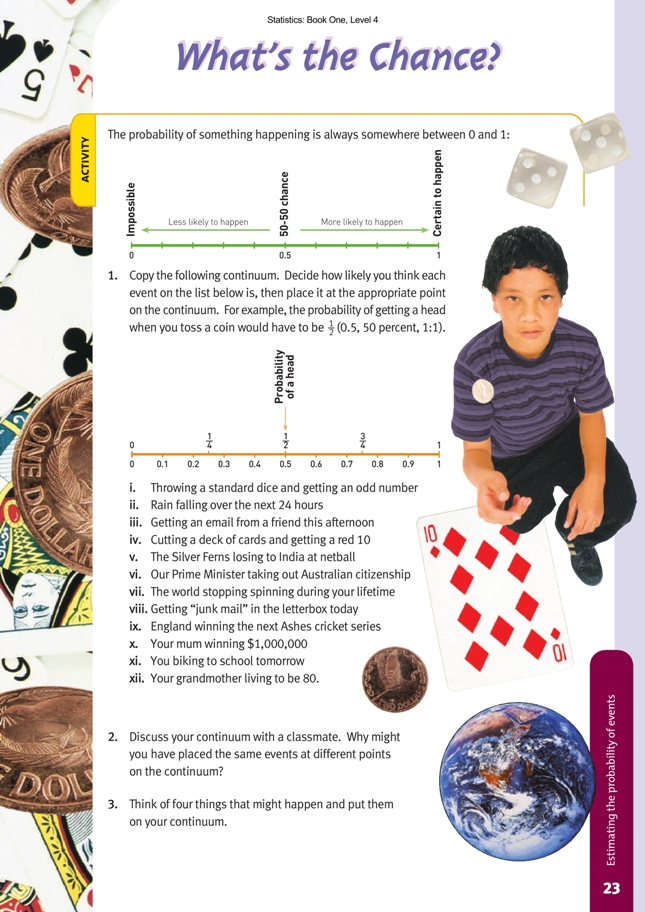This is a level 4 statistics activity from the Figure It Out series.
A PDF of the student activity is included.
Click on the image to enlarge it. Click again to close. Download PDF (774 KB)
place probability of events on a continuum
This activity establishes the key idea that probability can always be expressed as a number between 0 and 1. It also provides a useful context for learning how to place fractions and decimals on a number line.
The mathematical context of this activity is appropriate for students who are at stage 7 (advanced multiplicative part–whole) or 8 (advanced proportional part–whole) of the Number Framework. It provides a good followup to an introductory discussion on the concepts and language of probability.
An introductory discussion could begin with a question such as “What is the chance that someone will one day walk on the Sun?” The purpose of the question is to explore ways of describing a situation that has no chance of eventuating.
Hopefully, someone will suggest “zero” or “nil”; if not, you may need to prompt them. A follow-up question could be “Is it possible to find an event with a smaller chance (or probability) of happening than this?” Once you have established that if something is impossible, it has a probability of zero, the label “0” can be attached to the far left end of a line on the board or a length of rope on the floor. The line or rope represents a continuum. If you wish, the standard notation can be introduced at this point:
P (someone will walk on the Sun) = 0.
This is read as “The probability that someone will walk on the Sun is zero.”
The second challenge is to establish that if something is inevitable, it has a probability of 1. A suitable starter question could be “What is the chance that the Sun will come up tomorrow?” This should lead to the label 1 being placed at the far right end of the continuum represented by the line or rope.
Once the extremes of 0 and 1 are established, explore the meaning of the space between them. At first, you could get your students to judge whether an event is impossible, possible, or certain. Each event can be given a label and placed either at the appropriate extreme or in-between.
“What is the chance you will eat potatoes tonight?” Apart from opening up a discussion on family and cultural differences, a question such as this will generate responses like “not very high” that can then be quantified. A family may eat this vegetable 3 times a week, so the chance of potatoes on any particular night becomes
“3 out of 7” (unless the family has a rigid weekly menu, in which case the probability on any particular night may be 0 or 1!).
It is also important to discuss events where the probability is evenly balanced or nearly so. A suitable question could be “What is the chance that the next child born in our town will be a girl?”
This example could lead to the idea that there may be ways of calculating probability, at least in some circumstances. It could also be used to introduce the idea that a probability can be written as a fraction, leading to the understanding that “one out of two” can also be written as 1/2 .
Note that, because this is a different conceptual use for fractions, it is important not to assume that your students will automatically see that words like “3 out of 7” can be converted to a fraction, or that they can interpret a fraction written in the form 3/7 as a probability. Explicit teaching is needed.
Bear in mind that research shows that students often have difficulty using number lines. While they are an essential tool, do not assume that a student can read them or place numbers on them. This is especially the case when working with decimals or fractions.
Answers to Activity
1. Several are definite:
i. 1/2
iv. 1/26
v. 0. (India does not play netball at an international level.)
vi. 0. (The Prime Minister must be a New Zealand citizen.)
vii. 0, during your lifetime.
Other answers will vary greatly depending on personal circumstances and personal assessment.
2. Discussion will vary. In most cases, personal circumstances will determine that people come up with different outcomes, for example:
iii. Some will be keeping up frequent email correspondence with friends, and others won’t. So probabilities could vary from close to 0 through to 1. Someone who does not have a computer will have 0 probability of getting email unless they access it through someone else’s computer.
viii. Most will have a high probability of getting junk mail on any given day, perhaps 4 out of 5 (or 4/5 or 0.8). If, however, they live in an out-of-theway place, they may never get any, in which case the probability is 0.
ix. The assigning of probabilities to sports events is usually determined as much by personal loyalties and prejudices as anything!
x. Some mothers never buy lottery tickets, so they would have 0 probability of winning $1,000,000; others regularly buy tickets, in which case, the
probability is marginally greater than 0!
xi. Some will bike every day (giving a probability of 1), when it is not wet (this probability may be 9/10 or 0.9), and others never bike (in which case
the probability is 0).
xii. If Grandma has already died before her 80th birthday, the probability of her reaching 80 is 0; if she is nearly 80 and in good health, the probability may be 19/20 (or 0.95).
3. Events and placements will vary. Answers should be sensible.
